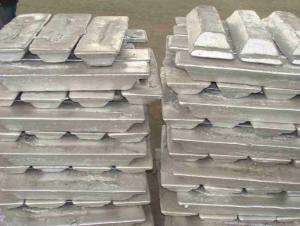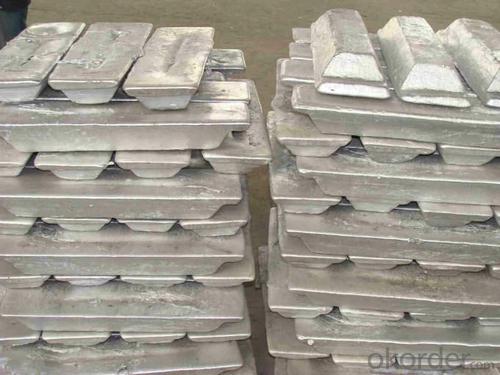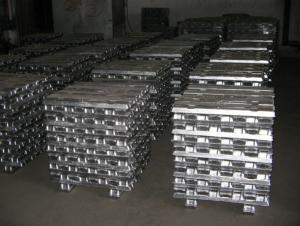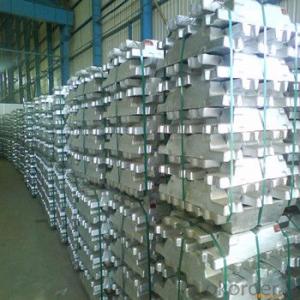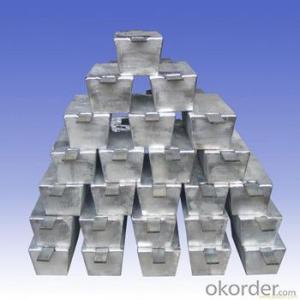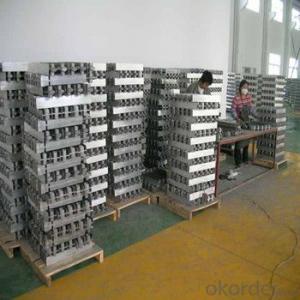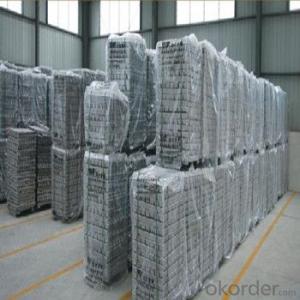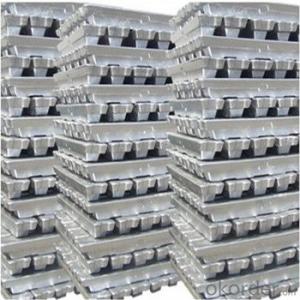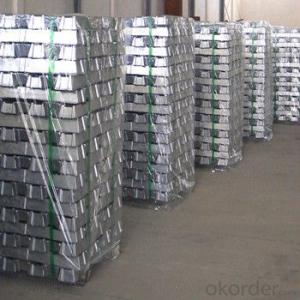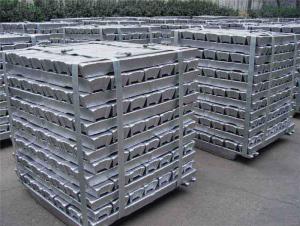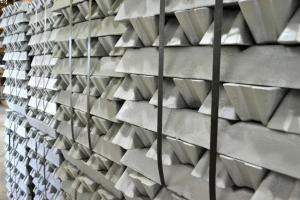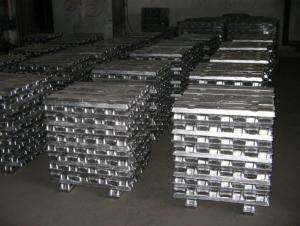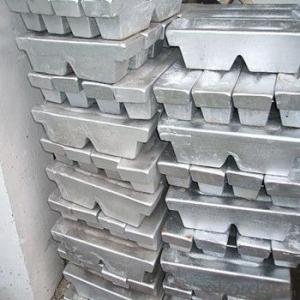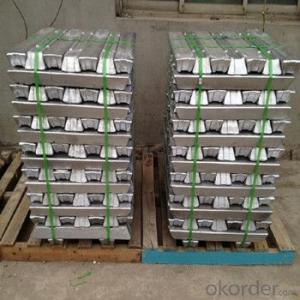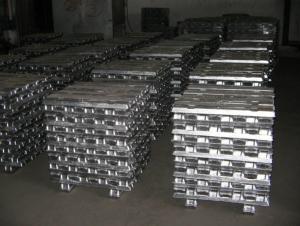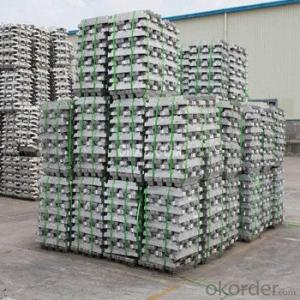Aluminum Ingots AA3105
- Loading Port:
- Shanghai
- Payment Terms:
- TT or LC
- Min Order Qty:
- 20 Tons m.t.
- Supply Capability:
- 1000 Sets Per Month m.t./month
OKorder Service Pledge
Quality Product, Order Online Tracking, Timely Delivery
OKorder Financial Service
Credit Rating, Credit Services, Credit Purchasing
You Might Also Like
1. Specifications of Aluminum Ingots AA3105
| Product Name | Aluminum Ingot |
| Chemical Composition | Al |
| Weight | 20/25kg |
| Al (Min) | 99%-99.9% |
| Appearance | silvery white |
| Advantages | easy control and operation, fast melting |
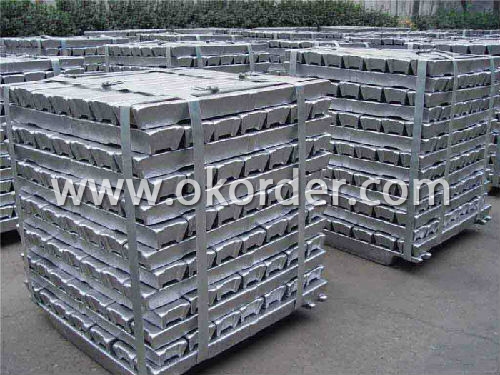
2. Usage/Application of Aluminum Ingots AA3105
A. mainly used for melting ingot
B. discontinuous melting with scrap
3.Packaging & Delivery of Aluminum Ingots AA3105
About 25Kg /Ingot, Packed in wooden case, Net weight 1000Kg/ Case, or as customer's requirements.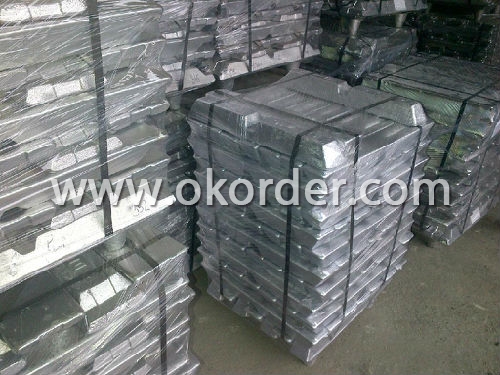
- Q: What are the dimensions of a typical aluminum ingot?
- The dimensions of a typical aluminum ingot vary, but they are commonly rectangular in shape and can measure approximately 20 inches long, 6 inches wide, and 3 inches thick. However, these dimensions can vary depending on the specific requirements and standards of the industry.
- Q: How are aluminum ingots used in the production of architectural structures?
- Aluminum ingots are commonly used in the production of architectural structures due to their lightweight, durability, and corrosion resistance properties. These ingots are melted down and cast into various shapes, such as beams, columns, and panels, which form the structural framework of buildings. The versatility of aluminum allows for the creation of intricate designs and enables architects to push the boundaries of innovative and sustainable architecture. Moreover, aluminum ingots can be easily recycled, making them an environmentally friendly choice for construction projects.
- Q: Aluminum profile manufacturers which good? How to choose?
- Explanation is as follows: aluminum material cost = aluminum ingot spot price, extrusion aluminum processing charge, packing material charge. These are transparent, the cost of aluminum profiles are similar, significantly lower than the market price, the first possibility: the weight per meter less; second: aluminum is the use of recycled materials; third: material loss amplification (not according to the actual sales amount of meters).
- Q: What are the main factors influencing the choice between aluminum ingots and aluminum slabs?
- The choice between aluminum ingots and aluminum slabs can be influenced by several factors. Firstly, the production process plays a crucial role. Ingots are commonly used for casting and shaping purposes due to their easy meltability and moldability. On the other hand, slabs are often utilized in rolling and extrusion processes to create thin sheets or various shapes. Secondly, the specific requirements of the end product can impact the decision. If the final product needs a particular shape or thickness, slabs may be preferred as they can be directly processed into the desired dimensions. However, if the product requires casting into complex shapes, ingots may be more suitable. Moreover, cost considerations also come into play. Ingots are generally cheaper to produce as they require less processing and have fewer quality requirements. Conversely, slabs may involve additional steps like rolling or extrusion, which can increase production costs. Market demand is another essential factor. If there is a higher demand for products derived from slabs, such as sheet metal or extruded profiles, then slabs would be preferred to meet the market needs efficiently. Additionally, the available production capacity and resources of a manufacturer can influence the decision. If a company has the necessary machinery and capabilities to process aluminum slabs efficiently, it may choose slabs over ingots to maximize its production capacity and resources. In conclusion, manufacturers must carefully evaluate the production process, product requirements, cost considerations, market demand, and available resources to make an informed decision regarding the use of aluminum ingots or slabs. By considering these factors, they can align their production capabilities with market demands effectively.
- Q: Can you melt the aluminium ingot?
- Cans are a mixture of several alloys, as well as aluminum surface treatment and printing impurities, etc., the production of aluminum alloy ingot sales is not a problem, mainly the price. In the domestic market Aluminum Alloy ingot is so large, that recycling aluminium ingot is simply not a thing.
- Q: What are the properties of aluminum ingots?
- Aluminum ingots possess several notable properties, including being lightweight, corrosion-resistant, and highly conductive of both heat and electricity. They have a low melting point, making them easily cast and molded into various shapes. Additionally, aluminum ingots are durable, non-toxic, and have a high strength-to-weight ratio, making them suitable for a wide range of applications in industries such as construction, automotive, and aerospace.
- Q: How is aluminium ingot produced?
- The production of aluminum ingot is made up of bauxite mining, alumina production, aluminum electrolysis and other production links.
- Q: It can be dissolved aluminum cans, aluminum ingots, need what equipment?
- A lot of cans are iron, not much aluminum.
- Q: What are the different testing methods for aluminum ingots?
- To evaluate the quality and characteristics of aluminum ingots, various testing methods are utilized. Some common testing methods for aluminum ingots include: 1. Analyzing the chemical composition of the aluminum ingot to determine the presence and quantity of different elements. This ensures that the ingot meets required specifications and standards. 2. Assessing the mechanical properties of aluminum ingots through tensile testing. This measures the ingot's ability to withstand tension and determines its ultimate tensile strength, yield strength, and elongation. 3. Measuring the resistance of an aluminum ingot to deformation or indentation through hardness testing. Various methods such as Brinell, Rockwell, and Vickers hardness tests can be employed to determine the ingot's hardness. 4. Utilizing ultrasonic testing to detect internal defects like cracks, voids, or inclusions in aluminum ingots. This non-destructive testing method ensures the structural integrity of the ingot. 5. Conducting visual inspection to carefully examine the surface of aluminum ingots and identify visible defects such as cracks, pits, or surface irregularities. This step provides valuable insights into the overall quality of the ingot. 6. Checking the physical dimensions and tolerances of aluminum ingots through dimensional inspection. This includes measuring the length, width, thickness, and other critical dimensions to ensure they meet required specifications. 7. Examining the microscopic structure of aluminum ingots using techniques like metallography and optical microscopy for microstructural analysis. This helps assess the ingot's grain size, phase distribution, and identify any abnormalities or defects in the microstructure. 8. Evaluating the behavior of aluminum ingots under high-stress conditions through impact testing. This measures the ingot's resistance to sudden impact or shock loading and determines its toughness and ability to withstand sudden loads. Employing these testing methods is crucial to ensure the quality, integrity, and performance of aluminum ingots. Manufacturers can identify flaws or defects and take appropriate measures to enhance the overall quality of the ingots.
- Q: Who knows but also can do aluminium ingots what products?
- Made of aluminum ingot is only the intermediate process, convenient transportation, adjustment of ingredients, etc.Also, a lot of scrap metal recycling scrap. Mainly re refining recycled, made of sheet bar form ingots
We are a well-known enterprise specializing in the production and sales of aluminum sheets and coils.
Since the establishment of us, we have been devoted to setting up a good CIS and completely implementing ISO9001 quality management system.
1. Manufacturer Overview
| Location | Henan,China |
| Year Established | 1993 |
| Annual Output Value | Above US$200 Million |
| Main Markets | Mid East;Eastern Europe;North America |
| Company Certifications | ISO 9001:2000;ISO 14001:2004;OHSAS 18001 |
2. Manufacturer Certificates
| a) Certification Name | |
| Range | |
| Reference | |
| Validity Period |
3. Manufacturer Capability
| a) Trade Capacity | |
| Nearest Port | Shanghai |
| Export Percentage | 30%-50% |
| No.of Employees in Trade Department | 21-50 People |
| Language Spoken: | English;Chinese |
| b) Factory Information | |
| Factory Size: | Above 100,000 square meters |
| No. of Production Lines | Above 10 |
| Contract Manufacturing | OEM Service Offered;Design Service Offered |
| Product Price Range | Average |
Send your message to us
Aluminum Ingots AA3105
- Loading Port:
- Shanghai
- Payment Terms:
- TT or LC
- Min Order Qty:
- 20 Tons m.t.
- Supply Capability:
- 1000 Sets Per Month m.t./month
OKorder Service Pledge
Quality Product, Order Online Tracking, Timely Delivery
OKorder Financial Service
Credit Rating, Credit Services, Credit Purchasing
Similar products
Hot products
Hot Searches
Related keywords
